Learn the four key ingredients-carbon-rich browns, nitrogen-rich greens, oxygen, and moisture-needed for fast, odor‑free composting and a nutrient‑rich garden amendment.
Compost C:N Ratio – What It Is and Why It Matters for Your Garden
When you’re making compost C:N ratio, the balance between carbon-rich and nitrogen-rich materials that determines how fast and cleanly your pile breaks down. Also known as carbon nitrogen ratio, it’s not just a number—it’s the secret to turning kitchen scraps and yard waste into rich, dark soil that plants love. Get it wrong, and your pile smells bad, takes months to break down, or just sits there. Get it right, and you’ll have usable compost in weeks, with no flies, no odor, and zero frustration.
This isn’t theory—it’s what works in Indian backyards. If you’ve ever tried composting with just leaves or just vegetable peels and ended up with a slimy mess, you know why the carbon and nitrogen balance matters. Carbon gives structure—think dry leaves, straw, paper, sawdust. Nitrogen feeds the microbes—think fresh grass clippings, coffee grounds, fruit peels, manure. The sweet spot? Around 25–30 parts carbon to 1 part nitrogen. That’s the range most successful home composters in India hit, whether they’re using a simple pile, a tumbler, or a vermicomposting bin.
Here’s the practical part: if your compost smells like rotten eggs, you’ve got too much nitrogen. Add dry leaves, shredded newspaper, or rice husks. If it’s dry and not breaking down, you need more green material—leftover roti, tea leaves, or even wet coconut husk. You don’t need a lab to check this. Just look, smell, and feel. A good pile is warm, crumbly, and smells like earth after rain. That’s the sign your C:N ratio is working.
And it’s not just about speed. The right balance means fewer pests, less odor, and compost that actually improves your soil—not just adds bulk. That’s why the posts below cover everything from simple homemade compost recipes to how to fix a stalled pile, how to use kitchen waste in Indian homes, and why vermicomposting works so well in small spaces. You’ll see how real gardeners in Delhi, Bangalore, and Chennai tweak their ratios based on what’s available seasonally—monsoon greens in June, dry mango leaves in November, leftover dal in the sink. No fancy tools. No expensive inputs. Just smart layering.
What follows isn’t a textbook. It’s a collection of what actually works on Indian balconies, terraces, and backyard plots. Whether you’re new to composting or you’ve been at it for years, you’ll find something here that helps you skip the guesswork and get better results faster.
